Introduction
There is a widespread agreement among authors, researchers, consultants and thinkers in the field of management that innovation is the central capability for all organizations interested in maximizing the opportunities for success in the 21st century. The environmental changes are faster and more demanding, so the innovation process is also changing –one of the directions of this change is the process of opening up. Furthermore, practitioners and theoreticians deal with the problems of managing innovation, seeking its determinants which can emerge by minimizing barriers to the creation and implementation of innovations. Core values are a decisive factor for a company’s innovation and performance. On the other hand, innovation can be practiced as well as learned. The goal of researchers is to show how to formulate and implement each determinant of innovation (i.e. core values) to promote the development of open innovations and their effective use in the development of the long-term values of an organization.
Core values in Innovation Process
Collins and Porras (2003) notice that: core values are the basic and lasting principles of any organization’s activities, which must not be departed from to achieve greater profit or to fulfill short-term assumptions, they even call them the primal. Soyer et al (2007) and Urde (2003) defined core values as guiding principles and behaviors of employees, while Cummings and Worley (2005) and Johnson et al. (2008) regarded core values as the basis of organizational culture and the organization itself. Oh et al (2018) defines core values as the shared beliefs and culture of an organization leading to visible and invisible performance principles that all members of the organization can act on to achieve organizational goals and objectives.
Collins and Porras (2003) point out that, such values do not undergo any fashion or trends, they are independent from the market situation and stress the authenticity of convictions. At the same time, they stress the fact that the “core ideology cannot be based neither on following other organizations, even the most outstanding ones, nor on following directives made by those from the outside of the company. Which of the above-mentioned values can be most practical, most popular or most profitable cannot be based neither on reading managerial literature, nor on some cold calculation”, Collins and Porras (2003). The core values can have their source within the organization, they can result from the true convictions (from what people believe in) or arise from a vision. It does not, however, mean that the values cannot change as Collins and Porras (2003) or Lencioni (2004) pointed out. Moreover, core values are used as a management control system to disseminate organizational objectives and purpose among employees Walecka-Jankowska et al. (2016) and stakeholders Jollands et al. (2015). As Campbell and Göritz (2014) notice that the set of core values, which is embedded in MNE ethical codes of conduct, is an integral part of organizational culture. Organizations that have well-defined overarching values in addition to striving to maximize assets, simultaneously achieve other set goals, Collins, Porras (2003). Core values make it easier for employees to identify the goals of the organization and to understand what is the most important premise for the existence of the company, what it is used for and what it wants to strive for, M. Bratnicki (2002), A. Devero (2003) and P. M. Lencioni (2002). The authors believe that if the innovation management is included in the core values, it will constitute a foundation for the employees’ engagement, and at the same time the expenditure on their control would be reduced. Moreover, the core values, being a filter for the organizational processes, would be easier to use in action. Table 1 shows how the common values influence the actions of the organization’s employees.
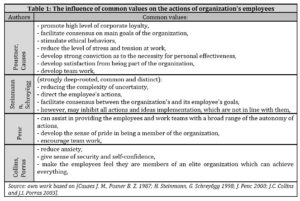
T. Watson believes that an organization that wants to use the full potential of its employees must find a reason to work together. This can be done through core values, thanks to which the company will release passion in employees and will always remain authentic, Collins and Porras (2003). An important function of the core values is to reduce employee uncertainty by setting certain performance standards that increase the predictability of behavior in the organization. Thanks to this, it is possible to limit all laws and regulations that block the creativity and innovation of colleagues, Hopej (2005). Employing employees who share the organizational values, create stronger bonds, which also translates into employees’ involvement in entrusted tasks, increase in mutual trust and over time, also increasing the loyalty between employees and organizations. This is particularly important in the case of open innovations, where the organization cooperates with other entities in the market. Common shared values allow all interested parties to move in the same direction, and cooperation is less exposed to misunderstandings related to other value systems professed by different entities. In addition, the right value system distinguishes the organization from competitors and creates its unique identity. In order to create and develop innovations, it is important that the content of core values is well thought out. Overarching values should convey such content that will motivate independent development, indicate knowledge and experiments, and undermine the status quo. The implementation of core values requires some effort on the part of all employees, they should relate to issues that are controversial and not easy, Lencioni (2004). In addition, creating innovation for businesses is an extremely difficult and complex process. Organizations must generate many ideas in a fairly short time to be able to keep up with the ever more dynamic environment. From all these ideas, the company must choose several ones for further research, and one or two will succeed, which will have a significant impact on the further functioning of the organization. In addition, innovations are subject to a high risk of failure, which discourages further attempts to improve them. That is why it is very important to motivate and encourage employees to think creatively. To make this possible, innovation may not only be a necessity for the entity to survive on plaster, but also should be entered in the basic value of the enterprise, which mobilizes the whole entity to creative action, Cagna(2017). Flexible adaptation from organizations is required by a dynamic and rapidly changing environment, but it does not mean that all organizational elements should constantly change – as Kolb (2003) believes – certain elements aimed at sustaining the continuity are essential and there is the danger of separating the organizations’ present and future from their past. The meaning of current changes and future aspirations is a link between the past, the present and the future, Kolb (2003). Furthermore, durability and flexibility are the basic attributes of the organization in the section of time. Satisfying the needs for flexibility is interrupted by durability of functions and organizational processes, while maintaining the stability leads to the perdition of flexibility, M. Bratnicki (2002). Therefore, the main hypothesis is: the more aware of core values employees are, the higher level of innovation.
Opening Innovation Process
Chesbrough and Bogers (2014) defined open innovation as follows: a distributed innovation process based on purposively managed knowledge flows across organizational boundaries. The main objective is to increase the enterprise’s innovativeness and to search for outlet markets for technologies and ideas which do not fit in the current business concept. In this regard, the concept comes down to three basic dimensions, Chesbrough (2003); inflow of knowledge, outflow of knowledge and business model. Dispersion of the innovation process through the inflow and outflow of knowledge occurs with the use of both monetary and non-monetary mechanisms, in accordance with the enterprise’s business model. This facilitates collaboration with various external entities and external specialists (customers, suppliers, R&D units and scientific institutions) in the scope of generating innovation. It means that the boundaries of an enterprise become an adopted barrier which makes it possible to improve the innovation at virtually any stage of the development process. Ideas unused by the enterprise are made available in the market free of charge or on the basis of licensing or similar agreements.
The scale of this continuum also includes innovation generated in a traditional manner through closed processes (based on the enterprise’s internal R&D activities, which are strictly controlled to prevent the competitors from gaining a market advantage). Only the ideas with the greatest potential are developed further to save time and reduce costs. This approach requires a high level of autonomy, extensive investment in R&D departments and appropriate procedures in place to protect the enterprise’s know-how.
According to the open innovation model, enterprises are able to acquire additional sources of income by selling ideas with lower potential for development. Moreover, they can broadly access knowledge and external experts, which reduces the time needed to develop innovation. Sharing know-how is the basic element which differentiates those two models. In the closed model, organisations often conduct a long-term research on innovation, incurring high costs, with no guarantee of success. A return on long-term investments could be achieved by selling them. However, Chesbrough (2003) stresses that the basic factor in the development of open innovation, is the significant increase in the number and level of mobility of knowledge workers. This, in turn, makes it more difficult to control their knowledge and ideas, Chesbrough (2003).
Researches on open innovation e.g. Chesbrough & Crowther(2006) and Gassmann & Enkel, (2006) show that enterprises often focus only on one of the first two dimensions of this concept – the inflow or outflow of technology, ideas and knowledge. In addition, each of those streams is used with a varying degree of openness. Cheng et al. (2014). Usually, this approach depends on the enterprise’s age and sector in which it operates. Mature businesses and those operating in low-tech sectors focus mainly on sharing their knowledge and ideas, and secondly, only on acquiring knowledge from the market. Whereas organisations linked to high-tech sectors are much more dedicated to gaining external knowledge than to making it available to others, Gassmann and Enkel (2006).
The authors proposed the division of open innovations, taking into account the opening of the innovation process in the examined organization. It was assumed that the opening of the process will be affected by whether the enterprise establishes cooperation with other organizations (various types of organizations were taken into account: an organization not cooperating with market players, an organization cooperating with various groups; suppliers, customers, competitors or research institutions) and how many activities are carried out together.
Research
The general aim of the research was to define the determinants of the open innovations, with a particular emphasis on the core values. These studies were conducted in Poland and 60 organisations operating in Poland were examined (they were different in terms of size, industry and owner-ship structure). One questionnaire was sent to each surveyed organisation with the request that a person with a broad view of the whole organisation (i.e. CEO, management team, quality specialist etc.) fill it in. The questionnaire included questions to measure the level of various determinants of innovations and the level of innovation. The survey also dealt with questions concerning certain characteristics in order to determine the structure of the surveyed organisations (size, the ownership and position of the organisation). Competent experts (scientists and senior managers) verified the accuracy of the items included in the questionnaire. The experts, independently of one another, made an individual assessment of the questionnaire. Each respondent received a questionnaire and a cover letter (which included the request for help in the research programme, the explanation of the aims and scope of the programme as well as the assurance of anonymity).
To investigate the results of the relation between open innovation and corporate values, the authors defined key variables: organizational culture with 3 variables: (tolerance for uncertainty and risk, focus on individuality and equality of employees and updating knowledge and challenging the status quo), organizational structure with 5 dimensions: (configuration, centralization, specialization, standardization and formalization), strategy formulation and technology: (routine and simplicity), environment: (hostility, variability and complexity), core values: (awareness of core values and focusing on innovation), distributed leadership, level of innovation and openness of innovation process – cooperation with different groups (suppliers, public institutions, clients and competition). The consistency of the key variable scales was checked by Cronbach’s α parameter (parameters are presented in table 1).
Table 1: Cronbach’s alpha for variables describing the enterprise
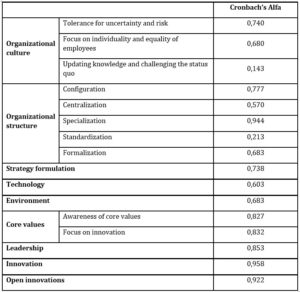
Source: Own compilation
Based on the results in the above table, it can be concluded that in most cases, the scale measures the studied phenomena well, since the alpha value is higher than 0.6. Organizational culture for the aspect of knowledge update and undermining the status quo of the company obtained an alpha result of 0.143. The low score is due to the fact that there is one question in this aspect, which separately measures the update of knowledge and the status quo of the enterprise. In two aspects of the organizational structure, the alpha value is below 0.6. These elements are centralization (0.570) and standardization (0.213). Standardization has a very low parameter rate because the two questions measure two separate substantive issues (the complexity of the activities performed and the need to act according to regulations and standards). The centralization aspect is slightly lower than the limit value, which may be the result of being examined with five questions, three of which relate to the location of problem-solving powers in the enterprise, and the other two relate to: communication flow (vertical or horizontal) and the location of responsibility for achieving higher-order goals. Alpha results were obtained for the technology, which slightly exceeds its limit value (0.603 in turn). This is due to the fact that this element was measured by 3 questions and these questions measured many aspects at the same time (technology measures, variability and complexity.
The next step of the analysis was the calculation of the correlation coefficient and regression. The correlation coefficient gives information about whether there is any relationship between individual variables. For the analysis of variables, the Pearson’s r coefficient was used, which shows a linear measure of the relationship between two variables.
Table 2:Correlation between variables

The last step of the statistical analysis was to conduct a series of regression analysis that allowed to examine the relationship between the opening of the innovative process (for various cooperation groups) and elements of the organization, with particular emphasis on core values. Regression was calculated only for the variables in which the correlation occurred. The regression results are shown in the following tables (2, 3, 4, 5, 6).
To predict the impact of organizational culture, strategy, overarching values and leadership on enterprise innovation, a step-by-step regression analysis was performed. The model was composed of seven predictors (organizational culture – three aspects, strategy, leadership and overarching values - two aspects), while only two significantly predict the level of enterprise innovation. The model is as follows: F (1.57) = 78.940; p <0.01. Predictors: leadership and strategy formulation make it possible to predict the level of enterprise innovation significantly, although it is worth noting that leadership is a slightly stronger predictor (beta = 0.535, p <0.01) than strategy formulation (beta = 0.396; p <0.01). Interpreting the obtained values of these two factors, it can be said that the more the enterprise leadership is focused on innovation and the more open the enterprise strategy is, which is focused on the future, the higher the level of enterprise innovation. The model is as follows: Y = -1.494 + 0.672 leadership + 0.836 strategy.
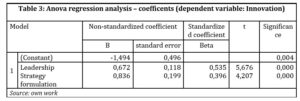
As it was assumed – opening the process will be affected by cooperation with other organizations (various types of organizations: an organization not cooperating with market players, an organization cooperating with various groups: suppliers, customers, competitors or research institutions) and how many activities are carried out together. To establish a relationship between different groups of cooperating organizations, the first regression analysis was performed for closed innovation (tab.4).

In order to predict the impact of a hostile environment on the innovations of open enterprises in the aspect of cooperation within the enterprise, a stepwise regression analysis was carried out. The model consists of one predictor, which is as follows: F (1.58) = 6.391; p <0.05. Interpreting the obtained values of this coefficient, it can be said that the lower the level of hostility in the environment in which the enterprise operates is, the higher the level of open innovation in the aspect of cooperation within the enterprise. The model is as follows: Y = 0.812 – 0.088 hostility of environment.
Next regression analysis was performed for cooperation with suppliers. In order to predict the impact of the level of tolerance for uncertainty and risk in organizational culture and configuration in the organizational structure on open innovations in the context of cooperation with suppliers, a step-by-step regression analysis was performed. The model has two predictors. The model is as follows: F (2.57) = 6.335; p <0.05. Predictors: the level of tolerance for uncertainty and risk, and configuration allow you to predict the level of enterprise innovation significantly, although it is worth noting that the culture aspect is a slightly stronger predictor (beta = 0.308; p <0.1) than formalization (beta = -0.280; p <0.05). Interpreting the obtained values of these two coefficients, it can be said that the higher the level of tolerance for uncertainty and risk of the company's organizational culture and the lower the configuration level is (the structure is flatter), the higher the level of open innovation in the context of cooperation with suppliers. The model is as follows: Y = 0.170 + 0.162 tolerance for uncertainty and risk – 0.121 configuration.
In order to predict the impact of organizational culture, environment and overarching values on open innovations in the aspect of cooperation with research institutions, a step-by-step regression analysis was carried out. The model consists of three predictors (organizational culture – tolerance level for uncertainty and risk, awareness of superior values and hostile environment), with only two significantly predicting the level of innovation open to cooperation with research institutions. The model is as follows: F (2.57) = 6.826; p <0.05. Predictors: awareness of superior values and hostile environment can significantly predict the level of enterprise innovation, although it is worth noting that awareness of superior values is a slightly stronger predictor (beta = 0.341; p <0.05) than hostile environment (beta = -0.259; p <0.05). Interpreting the obtained values of these two coefficients, it can be said that the higher the company's awareness of having superior values and the lower the level of hostility of the environment is, the higher the level of innovation open in the context of cooperation with research institutions. The model is as follows: Y = -0.047 + 0.224 awareness of superior values - 0.115 hostility of environment.
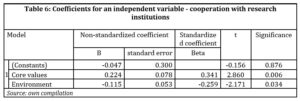
In order to predict the impact of centralization of the organizational structure on the innovations of open enterprises in the aspect of cooperation with clients, a stepwise regression analysis was performed. The model consists of one predictor, which is as follows: F (1.58) = 4.889; p <0.05. Interpreting the obtained values of this coefficient, it can be said that the higher the level of centralization is, the higher the level of open innovation in the aspect of cooperation with clients. The model is as follows:Y = -0.380 + 0.278 centralization.

The Core Values of The Surveyed Enterprises
One of the survey questions asked concerned the identification of the most important superior values professed in the surveyed enterprises. The list of these overarching values has been compiled on the basis of the most common values adopted by visionary organizations in the book by J. Collins and J. Porras. The results of this question are shown in Fig. 1. The four most common values occurring in the surveyed organizations are: high quality and reliability of products (23), being a leader in the industry (21), people as a source of strength (20) and excellent customer service (19). It can also be noted that the values related to innovation have low values: improving the quality of life through technology, improving the quality of life through innovation (2), supporting individual initiatives (4) and promoting the capacity and creativity of each individual (7). On this basis, it can be seen that rather few companies concentrate on innovation as a mail value.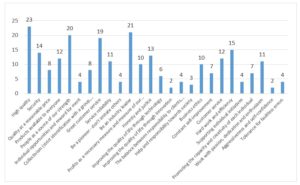
Fig. 1: The core values of the surveyed enterprises
Source: Own compilation
Conclusions
The role of core values on the level of innovation turned out to be not as strong as expected (but the correlation between innovation and core values is quite strong and significant). The most important conclusion is that the level of innovation in an organization is most influenced by leadership and strategy formulation. This may be the result of the fact that a strategy focused on innovation will “force” enterprises to pursue innovation. The strategy is the foundation that directs organizations in specific direction. Hence, the most important role of the leader is to shape a climate favorable to innovation in the organization and to determine the direction of action determining the field of innovation. Organizations wishing to grow in a dynamically changing environment must be flexible and innovative, and therefore, are under pressure to move toward an organic leadership paradigm that includes more leaders dispersed in different parts of the organization. It also means redefining leadership. Organizations no longer need one great leader who has knowledge in every field (must recognize the potential of employees and use itand provides support for changes that allow organizations to continue and develop in a turbulent and changing environment). At the same time, in the face of these frequent changes, leaders should ensure organizational continuity and a sense of identity by spreading a shared vision and shared values among employees. These two connected elements contribute the most to the innovativeness of entities. The most important factor that affects the closed innovation process is the environment hostility, but when taking opening of innovative processes into account, the important aspects are: open culture, i.e. the level of tolerance for uncertainty and risk as well as the configuration of organizational structure in cooperation with suppliers; awareness of superior values and a hostile environment when interacting with public institutions; centralization in cooperation with clients. A hostile environment is not conducive to cooperation with other market players, because there is a great danger that competitors will want to use the ideas and weaknesses of the company to gain a competitive advantage. It can even threaten the internal exchange of knowledge in enterprises, fearing the loss of important information that threatens the functioning of the organization. The organization does not even take any steps to establish cooperation, because it receives a clear message from the competitors that cooperation is not possible. So, the less hostile the environment is, the more the organization will be willing to look for new development opportunities for its products or services by establishing cooperation with public institutions, research units and universities. The second important aspect is organizational culture, or more precisely, the level of tolerance for uncertainty and risk. The high level of this factor has a positive effect on open innovation processes, because it allows to experiment, and at the same time does not impose for any mistakes and unsuccessful attempts. In addition, this attitude makes it easier to establish contacts with suppliers who will gladly undertake joint activities. The research shows that the flatter the structure is, the better it is for open innovation processes. This is due to the fact that a small number of management levels significantly improves the flow of information between employees, but also significantly eliminates possible distortions in messages. This also has a social aspect, as clear and transparent communication reduces tensions and conflicts both inside and outside the company. Another aspect is awareness of the supreme values held by organizations. In the long run, employees have clarity about the organization’s directions of activity, with high variability of environmental elements (e.g. customer requirements and technology). In addition, the company’s core values remain unchanged, giving those employees a sense of stability. Entities that clearly declare their values are better perceived by the environment, which makes it easier for them to establish cooperation. The convergence of goals may be an important aspect for research units, e.g. institutions are more willing to cooperate in ecology, animal rescue or minimizing the negative effects of production, which are recorded in the company’s overarching values. The last aspect that the analysis revealed is the high level of centralization. This is a surprising result in the light of previous assumptions and hypotheses, which say that the lower the centralization is, the better it is for open innovation processes. A high level of centralization in the cooperation of enterprises with clients may be important in enterprises dominated by the authoritarian style of management. It is based on the vision of a leader who shows the subordinates the direction of aspirations and the goal to be achieved. One of the strategic decisions of a leader may be just making a decision to cooperate with clients, which can bring many benefits. Long-term cooperation with customers can contribute to the lasting success of the organization and achieve competitive advantage by better satisfying the needs of consumers. Mutual cooperation not only contributes to the improvement of the organization’s products, but also builds relationships that can transform over time into customer loyalty to a given enterprise, and as known, it is the company’s most important asset.
Future research should include a larger research sample (current should be considered as a pilot study). It would be important to examine the relationship between overarching values for the next stages of the process of creating and implementing innovation.
(adsbygoogle = window.adsbygoogle || []).push({});
References
- Bratnicki, M. (2002) ‘Przedsiębiorczość i przedsiębiorcy współczesnych organizacji’, Wydaw. Uczelniane Akademii Ekonomicznej im. Karola Adamieckiego, Katowice.
- Campbell, J.L., Göritz, A. S. (2014), ‘Culture corrupts! A qualitative study of organizational culture in corrupt organizations’, Journal of Business Ethics, 120, 291–311.
- Causes, J.M. and Posner, B.Z. (1987), ‘The Leadership Challenge’, Jossey – Bass.
- Collins, J. C. and Porras. I. (2003), ‘Wizjonerskie organizacje. Praktyki Zarządzania, Najlepszych firm’, SPM Project.
- Cummings, T.G. and Worley, C.G. (2005), Organization Development and Change, Thomson, South-Western, Mason, OH.
- Cheng, C. and Huizingh, E. (2014). When Is Open Innovation Beneficial? The Role of Strategic Orientation.[Online]. Journal of Product Innovation Management, [22.03.2019]. Available: https://www.researchgate.net/publication/264573905_When_Is_Open_Innovation_Beneficial_The_Role_of_Strategic_Orientation.
- Chesbrough, H. (2003), ‘The Era of Open Innovation’, MITSloan Management Review 44 (3), 35-41.
- Chesbrough, H. and Bogers, M. (2014). Explicating Open Innovation. [Online]. [22.03.2019]. Available: https://www.oxfordscholarship.com/view/10.1093/acprof:oso/9780199682461.001.0001/acprof-9780199682461-chapter-1.
- Chesbrough, H. and Crowther, A. (2006), ‘Beyond high tech: early adopters of open innovation in other industries,’ R&D Management 36 (3), 229-236.
- Choi, J.Y. (2013), ‘The relationship among core value practice, core value education, core value development activity and organizational trust of employees in large corporations’, master thesis, Seoul National University, Seoul.
- Devero, A. (2003). Corporate values: Stimulus for bottom line.[Online]. Financial Executive Magazine, May. 1-4. [22.03.2019]. Available: http://www.fwconsulting.com/content/documents/Corporate%20Values%20%20Stimulus%20for%20the%20Bottom%20Line%202003%20v2a.pdf.
- De Cagna, J. (2017). The Six Core Values of Innovation, December 2017. [Online]. [22.03.2019]. Available: https://changethis.com/manifesto/download/41.03.SixCoreValues.
- Gassmann, O. and Enkel, E. (2006), ‘Constituents of Open Innovation: Three Core Process Archetypes’, R&D Management.
- Hopej, M. (2004), Struktury organizacyjne, Zakład Narodowy im. Ossolińskich, Wrocław.
- Johnson, G., Scholes, K. and Whittington, R. (2008), Exploring Corporate Strategy: Text and Cases, 8th ed., FT Prentice Hall, Harlow.
- Jollands, S., Akroyd, C., Sawabe, N., Burns, J., and Burns, J. (2015), ‘Core values as a management control in the construction of “sustainable development’, Qualitative Research in Accounting & Management, 12(2), 127–152.
- Kolb, D. G. (2003),‘Seeking continuity amidst organizational change: A storytelling approach’,Journal of Management inquiry, 12(2), 180-183.
- Lencioni, M. P. (2004), Niechwartościnaprawdęcośznaczą, Harvard Business Review Polska, 5, 120-125.
- Oh, J., Cho, D., and Lim, D. H. (2018), Authentic leadership and work engagement: the mediating effect of practicing core values, Leadership & Organization Development Journal, 39(2), 276-290.
- Penc, J. (2000), Motywowanie w zarządzaniu. Wyd. Profesjonalnej Szkoły Biznesu, Kraków.
- Schreyogg, G. and Steinmann, H. (1998), Zarządzanie podstawy kierowania przedsiębiorstwem, koncepcje, funkcje, przykłady, Wydawnictwo: Politechnika Wrocławska, Wrocław.
- Soyer, A., Kabak, O. and Asan, U. (2007), ‘A fuzzy approach to value and culture assessment and an application’, International Journal of Approximate Reasoning, 44(2), 182-196.
- Urde, M. (2003), ‘Core based corporate brand building’, European Journal of Marketing, 37(7/8), 1017-1040.
- Walecka-Jankowska, K., Zgrzywa-Ziemak A. andZimmer J. (2016), ‘Core values and innovation – empirical research’, in: Challenges for contemporary management / sci. eds. Natalia V. Trifonova, JanuszTeczke, Piotr Buła. Cracow Cracow University of Economics, 219-230











